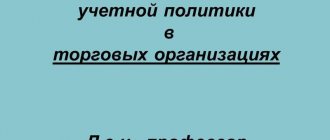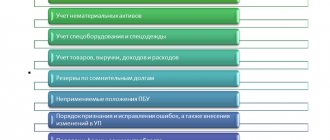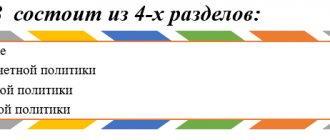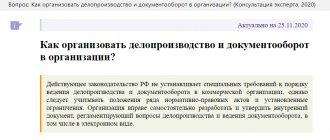Video recording and transcript of the webinar by Daria Vakhotina on the topic of accounting and write-off of inventories in the activities of individual entrepreneurs and limited liability companies. The webinar was held.
The topic of our webinar is the main provisions of the accounting policies of individual entrepreneurs and LLCs. In particular, we will look at inventory accounting and write-off. Our webinar will consist of four sections:
- The concept of inventory. What is included in inventories.
- Purchase of supplies.
- Write-off of inventories.
- Sales of inventories.
Purchase of inventory
In accounting and tax accounting, materials are valued at actual cost. This provision must be reflected in the accounting policies. The actual cost of inventories purchased for a fee is the amount of the organization's actual costs for the acquisition, excluding value added tax and other reimbursed taxes.
Examples of costs that can be included in the cost:
- Purchase price excluding VAT and excise taxes;
- Cost of non-returnable containers and packaging;
- Import duties and fees;
- Costs for transportation of raw materials and materials;
- Commission paid to the intermediary;
- Other expenses directly related to the purchase of raw materials and materials.
Example:
The company entered into an agreement for the delivery of materials with the manufacturer. The cost of materials under the contract is 118,000 rubles, including VAT of 18,000 rubles. The deal was concluded through an intermediary commission agent. The commission agent's remuneration is 10% of the transaction amount. The cost of packaging materials is 1000 rubles. It is necessary to calculate the cost of acquisition.
The cost of purchasing materials can be calculated as follows:
- Let's determine the cost of materials without VAT:
118,000 rubles – 118,000 rubles *18/118 = 100,000 rubles. - To determine the amount of the commission agent's remuneration, it is 10% of the transaction value.
That is, 118,000 * 10% = 11,800 rubles. - To determine the cost of purchasing materials, you need
100,000 rubles + 11,800 rubles + 1,000 rubles = 112,800 rubles.
Documentation of receipt of materials:
- Power of attorney to receive materials if they are received not by the director, but by a financially responsible person. The power of attorney must be notarized.
- Sales receipts;
- Invoices;
- Certificate of acceptance of goods in the form TORG-1. This act is not used every time and is used exclusively by large companies when this is stipulated by the terms of the contract. To draw up this act, it is necessary to assemble a special commission.
Example:
Now in front of you is the M-2 power of attorney form (see Figure 1).
Figure 1. Power of attorney M-2 to receive inventory items
In this form you must fill in the following fields:
- Date of issue;
- Validity;
- The organization issuing this power of attorney;
- Account number of this organization;
- Who issued this power of attorney;
- To whom this power of attorney was issued;
- Passport series and number, date of issue;
- A list of material assets that the bearer can receive under this power of attorney.
Sales receipt
The sales receipt lists the material assets that were purchased using this receipt. It must also have a stamp, the signature of the seller, the amount of VAT, the price, the amount of material assets purchased and the units in which they are measured.
Act in the form TORG-1
This is a two-page act, which is filled out by a commission that checks the quantity, quality and all the necessary parameters of material assets. However, there is a disagreement between tax specialists and accountants. Tax officials believe that TORG-1 must be filled out when accepting material assets. Since this invoice is a supporting document for the acceptance of goods.
Question: where is the notarization of a power of attorney provided?
When a power of attorney is issued, it must be certified by the seal of the organization.
The second page of the act lists the members and chairman of the commission. Most often, the chairman of the commission is the director. Signatures and seals must be present here.
Invoice
The invoice must contain:
- Number;
- date;
- Seller and recipient;
- Payment document number;
- Addresses, INN, checkpoint;
- A list of what the invoice was issued for.
Regulatory information
Speaking about the possibilities of using inventory valuation methods in practice, first of all, you should pay attention to the fact that currently regulatory documents on accounting and the Tax Code of the Russian Federation provide organizations with various opportunities to choose a method for valuing inventories for the purposes of financial accounting and tax accounting, respectively. In the first case, we are talking about the formation of the organization’s accounting policy, in the second - the accounting policy for tax purposes. Current accounting regulations do not provide for the possibility of using the LIFO method. According to the Tax Code of the Russian Federation, when forming an accounting policy for tax purposes in terms of income tax, organizations can choose any of the 4 methods we have considered.
Let us present the relevant requirements of regulatory documents that give exactly those definitions of inventory valuation methods that should be followed in the practice of financial and tax accounting.
Write-off of inventories
At this stage, the most important thing is to decide on the method of writing off inventory. PBU offers three options:
- At the cost of each unit;
- At average cost;
- At the cost of the first acquisitions of inventories (FIFO method).
The most popular method of writing off inventory is the FIFO method, since it allows you to account for goods at the most current cost. It is important to remember that the chosen inventory write-off method cannot be changed during the year. It can be changed, but only from the year following the reporting year.
Write-off method at cost of each unit
This method is convenient for those who have a small range of products. This method is used only for certain types of inventories. Namely, for materials that are used in a special order and stocks that cannot be replaced with each other. For example, precious stones, metals and radioactive materials. Since there are quite a few enterprises using these materials, this method is used quite rarely.
Example:
At the beginning of the month, the balance of materials was 300 units at a price of 110 rubles per unit for a total amount of 300 * 110 = 33,000 rubles. There were three arrivals during the month:
- 1st batch: 500 units at a price of 130 rubles per unit for a total amount of 65,000 rubles.
- 2nd batch: 600 units at a price of 170 rubles per unit for a total amount of 102,000 rubles.
- 3rd batch: 200 units at a price of 180 rubles per unit for a total amount of 36,000 rubles.
The total quantity of materials is 1600 units. The total cost of all materials is 236,000 rubles. During the month, 1,200 units of inventory were consumed. Accordingly, 400 units remain.
Write-off at average cost
This method consists in dividing the total cost of materials by their quantity. Including all balances at the beginning of the month and all their receipts.
Example:
At the beginning of the month, the balance of white paint in the organization was 150 kg. The average cost is 60 rubles per 1 kg. There were three paint deliveries during the month:
- 02/02/2013 – 60 kg at a price of 65 rubles per 1 kg;
- 02/15/2013 – 500 kg at a price of 57 rubles per 1 kg;
- 02/27/2013 – 100 kg at a price of 62 rubles per 1 kg.
350 kg of paint were used within a month. Consequently, the average cost will be 58.77 rubles per 1 kg. Based on this, you can calculate at what price to write off 350 kg of paint. It turns out 20,5569.50 rubles. The remainder of the paint in the warehouse will be 460 kg, its cost will be 27,034.2 rubles.
FIFO method
A method in which materials are written off at the cost of the first materials arriving at the warehouse. That is, the prices in the warehouse will always be current market prices. The largest number of accountants use this method.
Example:
The following data is available on the remaining materials in the warehouse:
Remaining: 50 units at a price of 23 rubles.
Received:
- 02/01/2013, 23 units at a price of 23 rubles;
- 02/15/2013, 42 units at a price of 22 rubles;
- 02/17/2013, 30 units at a price of 24 rubles.
In just one month, there were 145 units in stock. 80 units consumed per month.
- It is necessary to determine the cost of the materials used: (50*23)+(23*23)+(7*22)= 1833 rubles.
- The balance is 35 pieces at a price of 22 rubles, 30 pieces at 24 rubles for a total of 1,490 rubles.
Write-off of inventories under the simplified tax system
Material costs can be taken into account at a time at the time of payment or commissioning of the property, subject to payment. This provision is enshrined in Articles 346.17 and 254 of the Tax Code of the Russian Federation. But it is relevant only for those who are on the simplified tax system.
Results
Comparing the LIFO and FIFO methods thus shows us a very important contradiction. By obtaining (using the FIFO method) the opportunity to most adequately assess inventory balances, we distort the amount of profit reflected in the reporting. By estimating profit most realistically (using the LIFO method), we distort the estimate of the firm's inventory as reported as an asset on the balance sheet. This situation is a special case of the general paradox of accounting methodology based on the balance sheet equality of assets and liabilities, defined by Professor Ya.V. Sokolov (1938-2010) as the principle of complementarity*. According to this principle, the more accurate (adequate, close to reality) assessment one indicator of financial statements receives, the less accurate assessment is received by another indicator associated with it. In our case, such a related “pair” of indicators is inventories and profit.
Note:
* I'M IN. Sokolov. Fundamentals of accounting theory - M.: Finance and Statistics, 2000, pp. 38-39.
It is therefore obvious that the FIFO method is more focused on the tasks of preparing a balance sheet, and the LIFO method is more focused on the income statement. The dominant role of the balance sheet or statement of financial position has now led to the abolition of the LIFO method as recommended by Russian accounting standards and IFRS. However, the LIFO method remains relevant for estimating expenses and profits in management accounting. And it is in management accounting, provided that the assessment of the relevant indicators is important for making management decisions, that we can use the FIFO method in the formation of the management balance sheet and the LIFO method for drawing up the management income statement.
In financial accounting, when choosing between the FIFO method and the average price method, we should not forget about the analytical significance of the profit level as a signal for the payment of dividends. The perception of such a signal by the company's owners, which is inadequate to the real state of affairs, can, in conditions of a significant increase in prices for inventories, lead to the irrational withdrawal of funds from the company's turnover. Based on this, the average price method, when you have to choose between it and FIFO, in our opinion, is more consistent with the principle of prudence (conservatism), allowing you not to instill excessive optimism in the hearts of users of financial statements.
As for tax accounting and the organization’s accounting policy for tax purposes, here the correctness of choosing the LIFO method in conditions of rising prices, in our opinion, is completely indisputable.
Sales of reserves
Since inventory is not the main activity, 91 accounts are used. Accordingly, the following entries are made: debit 62, credit 91.1. Here you need supporting documents such as a sales contract and a delivery note in the TORG-12 form. Next, the cost of materials is written off to account 91, posting 91.2, credit 10. An accompanying certificate and calculation is required here.
Question:
And if they have not yet been put into operation, but have been spent, can they be written off?
It is a prerequisite that the materials be put into operation. If you use the cash method, you must make payment first.
Next, you need to charge VAT for tax purposes on payment and shipment. There will be two different entries - 91.2, credit 76 for payment and 91.2, credit 68 for shipment. This depends on which revenue recognition method is used. The supporting document will be an invoice. Next, money is received - debit 51, credit 62. The last entry is the calculation of VAT. Debit 76, credit 68. The supporting document is the invoice.
"Input" VAT
As a general rule, the amount of input VAT is deductible if:
- purchased goods are subject to VAT;
- there is an invoice;
- goods have been registered.
Once all these conditions are met, VAT can be deducted. If payment is made in cash, a sales receipt is required. VAT can be deducted only if the organization operates on the general taxation system. This rule does not apply to those who work under the simplified tax system. Since their type of activity is not subject to VAT. You can switch to the simplified tax system no later than December 31 of the year preceding the reporting year.
FIFO method. Calculation example
This is the most popular cost calculation method. It uses the queuing principle. It is assumed that the items that were delivered first are written off first. Hence the name FIFO method (English: “first in, first out” - “first in, first out”). However, unless the shelf life is important, it is not necessary to ship goods from an earlier delivery first - this is used as an assumption in the calculations. That is, the cost of goods that are sold first is calculated at the price of the balances from the “oldest” delivery. When the balances are quantitatively exhausted, inventory items are written off at the price of the next delivery, then the next one, and so on.
Example of calculation using the FIFO method
Let’s take our “Stationery” store with ballpoint pens and exactly the same situation as above. We have 370 ballpoint pens for 10 rubles and are supplied in two batches of 500 pens - first for 9 rubles 50 kopecks, then for 9 rubles. 1100 pens sold for 15 rubles. We count the profit.
FIFO or average cost - which is better?
Both of these methods work quite well. However, FIFO is considered more accurate than the average cost method. It is especially beneficial in terms of taxes if the price of the goods you purchase is constantly decreasing. Then the cost of the written-off goods will be the greatest, and the balance will be the minimum. Therefore, the answer to the question of which is better, FIFO or average cost, in most cases will be the first option.
Adjustment of the cost of written-off materials to the weighted average cost
Adjustment of the cost of written-off materials is carried out automatically when performing the routine operation Adjustment of item cost in the Month Closing in the Operations - Period Closing - Month Closing section.
Postings according to the document
Adjustment of the rolling cost to the weighted average cost will be carried out only in cases where there will be receipts from disposed inventories within a month after their disposal.
The document generates the posting:
- Dt Kt 10.01 - adjustment of the rolling cost to the weighted average cost.
Control
Let's calculate the amount of adjustment to the cost of the material Paper "Snow Maiden"
The calculated amount (-175.77 rubles) corresponds to the amount when performing the routine operation Adjustment of item cost in the Month Closing , therefore, the write-off of materials was carried out correctly.
Test yourself! Take a test on this topic using the link >>
See also:
- Document Requirement-invoice
- Closing accounts 20, 23, 25, 26
Did the article help?
Get another secret bonus and full access to the BukhExpert8 help system for 14 days free of charge
Related publications
- Write-off (transfer into operation) of business equipment as part of distribution costs Household equipment: office furniture and equipment, stationery, tools, etc....
- Test No. 25. Write-off of materials for general business needs...
- Test No. 39. Write-off (transfer into operation) of business equipment as part of distribution costs...
- Test No. 38. Acquisition and use of materials (household equipment) for non-production purposes...
FIFO method in warehouse program
Despite the fact that the FIFO method is quite simple in terms of understanding the principle of its operation, manually calculating the cost each time is very labor-intensive. Especially if you have a small business, and you yourself are the director, the cashier, the accountant, and the chief buyer. It is much easier if you simply enter data on deliveries and sales and immediately get the result. This is exactly how you can work with the MyWarehouse service. The program fully automates trading processes and itself calculates the cost of written-off goods using the FIFO method. MyWarehouse calculates profitability for each product or product group, stores and displays current and historical balances, as well as many other data that may be useful. This way, you save time and can be confident in the accuracy of the indicators on which you make decisions.
Company accounting policy
According to the law, the organization itself chooses how to calculate the cost of goods. It is important that the method you consider is necessarily reflected in the company's accounting policies. This is stated in Article 313 of the Tax Code of the Russian Federation, as well as in paragraph 73 of the Methodological Instructions approved by Order of the Ministry of Finance of Russia dated October 28, 2001 No. 119n.
Changes to accounting policies can be made once a year. That is, you can deposit them earlier, but they will take effect according to the law next year - at the beginning of the new tax period. The accounting policy is drawn up by an accountant and approved by the head of the organization.
For management accounting purposes, you are free to use any costing method. Our advice is to use the same one that is written down in your accounting policy - this way there will be less confusion.
The second option is by determining the price at the time of material release (sliding price)
The method of writing off materials at average monthly prices provided in the first option may cause inconvenience in the practical application of this option due to the fact that the price, as a rule, can only be determined at the end of the month, after calculating monthly turnover.
An organization can use the second option for valuing material by determining the price based on the condition of the material at the time of release, without waiting for the end of the month.
In this case, recalculation of the average price of the material can be carried out based on the option chosen in the organization (average cost, FIFO) at the time (as) of each material issue. In this case, the calculation algorithm is similar to the procedure outlined in the first option.









